Medical and Non-Newtonian Flows
Selected Research Projects
Predicting Blood Flow in Intracranial Aneurysms in Order to Predict Rupture
As part of the Research Campus STIMULATE with Grant Number 13GW0095A
Responsible person: Dr.-Ing. Philipp Berg
See also: https://www.forschungscampus-stimulate.de
Intracranial aneurysms are abnormal bulges formed in the human cerebral vessels. These can occur even in young people and may lead to a quick death or irreversible disabilities in case of rupture. Numerical methods are being increasingly employed to estimate the risk of rupture (see figure). This approach is risk-free for the patient and allows for the detailed description of the individual hemodynamics.
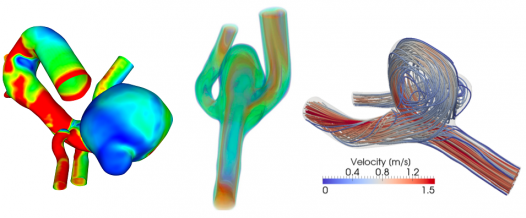
Figure: Representation of hemodynamic parameters in patient-specific aneurysms. Shear stress at the wall (left), 3D volume rendering of the blood flow velocity (center), speed-coded streamlines (right).
Large-Eddy-Simulations of air flow through human larynx
Responsible person: Dr.-Ing. Samuel Voß
Large eddy simulations are used in order to investigate the transitional air flow inside the human larynx. Patient-specific geometries based on CT imaging represent very realistic flow domains for CFD. The resulting velocity fields of healthy and pathological larynx can be compared to deepen the understanding of air flow related effects on respiration and speech quality.
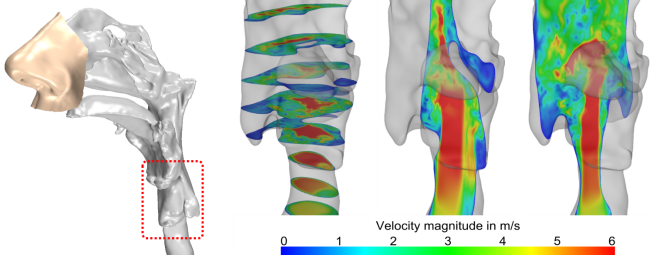
Figure: Large eddy simulations of air flow through human larynx.
Optimization of the Geometry of a Flow Diverter
Responsible person: apl. Prof. Dr. Gábor Janiga
In order to support physicians in intervention planning, treatment methods are modeled virtually and subsequently improved according to the individual patient. An example here is the treatment using so-called flow diverter stents that, due to their fine-mesh structure, decrease blood flow to an aneurysm and initiate thrombosis.
This project focuses on the optimization of flow diverter stents to enable an automatic and patient-specific treatment. To this end, various software tools need to be coupled by OPAL++ to allow for the rapid and robust examination of different patients. In this project, a test geometry was already successfully investigated and improved (see videos).
Figure: Representation of the blood flow velocity in a patient-specific aneurysm before (on top) and after (on bottom) treatment with a flow diverter stent.
Experimental Flow Measurements in Order to Validate Blood Flow Predictions
As part of the Research Campus STIMULATE with Grant Number 13GW0095A
Responsible person: Dipl.-Ing. Christoph Roloff
See also: https://www.forschungscampus-stimulate.de
Computational Fluid Dynamics (CFD) is a promising tool in better understanding hemodynamic processes and in finding or optimizing solutions to related problems. However, due to the model-like simplifications that were inevitably made, the validation of such calculations remains essential. Therefore, high-resolution in-vitro flow measurements with advanced optical methods (Particle Image Velocimetry (PIV), Particle Tracking Velocimetry (PTV)) are continuously being worked on within the project to further boost confidence in the simulations. In particular, the investigation of cerebral aneurysms in conjunction with flow affecting medical implants (flow diverter, stent, etc.) stands at the center of this research.
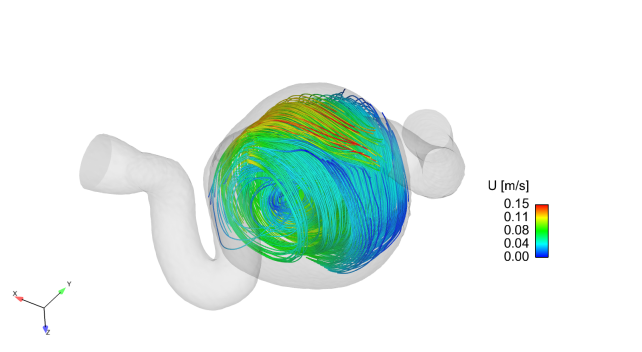
Figure: Streamlines within a patient-specific geometry of an aneurysm measured by stereo PIV on a silicone model.
Fluid-Structure Simulation of Intracranial Vessels and Aneurysms
As part of the Research Campus STIMULATE with Grant Number 13GW0095A
Responsible person: Dr.-Ing. Samuel Voß
See also: https://www.forschungscampus-stimulate.de
Fluid-structure simulation represents an extension of the meanwhile well-established fluid mechanical simulation of intracranial aneurysms. Next to hemodynamics, this also depicts the wall of the vessel along with its properties. The focus is a detailed as possible description of these complex interactions, including any mechanical wall characteristics and pathology. Goal is to gain a deeper understanding of the active mechanisms and to therefore develop a rupture risk model.

Figure: Section through an aneurysm and the pathway of wall tension as well as the speed-coded internal streamlines.
Numerical Modeling of Blood Damage in Fluid Flows
Responsible person: M.Sc. Sebastian Engel
Flow simulations are an importing building block in the development on low-impact medical products. The development of blood-wetted devices such as blood pumps is especially challenging. Blood can be exposed to impacts more severe than natural ones in such artificial environments, which can result in damages to the blood. Damages can result on multiple levels, especially in cellular components: red and white blood cells (erythrocytes and leukocytes) and blood platelets (thrombocytes).
It is necessary to model these damages in order to numerically improve blood flow in artificial devices, for which there are numerous approaches. In ongoing research, modeling methods are being analyzed, compared to each other, and implemented in simulation tools. An emphasis here was placed on the modeling of hemolysis (mechanical damage of red blood cells).
This work provides a basis for the systematic numerical optimizations of blood-wetted devices, e.g., blood pumps. The same methods can, however, also be expanded to other applications such as oxygenators or natural diseases such as stenosis.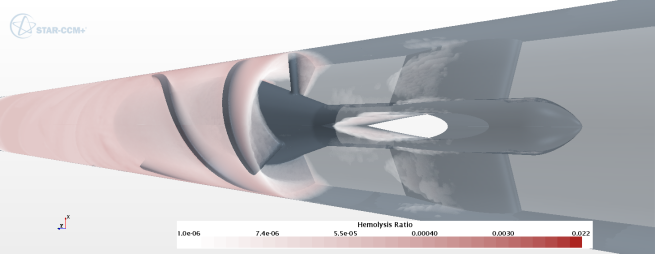
Figure: Spatial distribution of the hemolysis ratio (concentration of hemoglobin in the plasma) in an axial blood pumps. Represented in a volume-rendered distribution. Side view of the impeller and the guide wheel.
Influence of Polymers and Fibers on Pressure Drop in Turbulent Channel Flow
Responsible person: Dr.-Ing. Amir Eshghinejadfard
How the addition of small amounts of additives to fluids effects pressure loss is of great industrial interest. Therefore, this project is experimentally investigating which change in pressure drop can be achieved in a quasi-two-dimensional channel flow with the addition of various materials. The investigations cover a broad area of Reynolds numbers in the channel and material concentrations of two different polymers and five different fiber types. For example, the use of xanthan gum reduced the pressure drop by 22%, an effect that could not be achieved continuously. Using rod-shaped carbon fibers a pressure drop reduction of 3% was observed. Overall, a dependency on the aspect ratio (shape) of the fibers, however, no dependency on Reynolds number is displayed.
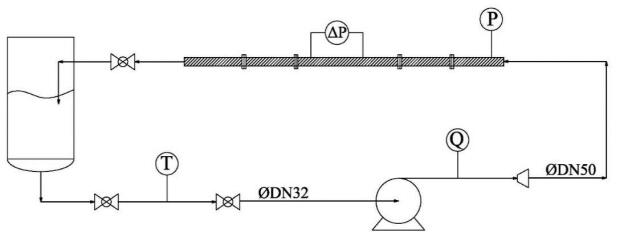
Figure: Schematic layout of the test facility for the investigation of the influence of additives on pressure drop in the flow channel.
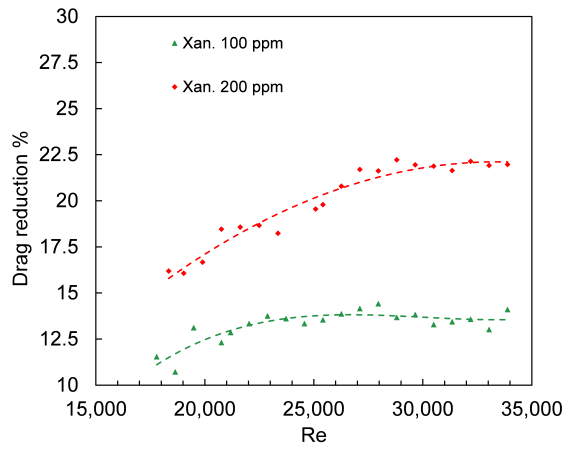
Figure: Pressure drop reduction as a function of the Reynolds number for xanthan gum.